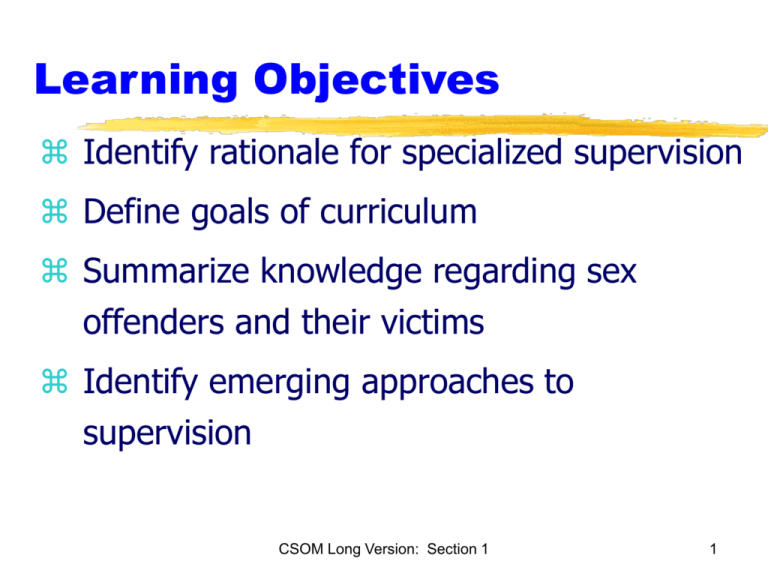
Learning Objectives
Identify rationale for specialized supervision
Define goals of curriculum
Summarize knowledge regarding sex
offenders and their victims
Identify emerging approaches to
supervision
CSOM Long Version: Section 1
1
Goals of this Curriculum
Identify challenges of community
supervision
Learn from other jurisdictions
Recommend safe and effective approaches
CSOM Long Version: Section 1
2
Training Segments
Section 1: Overview
Section 2: Innovations in Supervision
Section 3: Components of Supervision
Section 4: Sex Offender-Specific Treatment
in the Context of Supervision
Section 5: Practical Supervision Strategies
CSOM Long Version: Section 1
3
Who are Victims?
Three Studies that Document Sexual Victimization
in the United States
1.) Kilpatrick, Edmunds, & Seymour, (1992).
Rape in
America: A Report to the Nation
2.) Tjaden & Thoennes, (1998). Prevalence, Incidence,
and Consequences of Violence Against Women
3.) Saunders, (2000). National Survey of Adolescents
3.) Saunders, (2000). National Survey of Adolescents
CSOM Long Version: Section 1
4
Findings
Rape in America
78 rapes per hour of women 18 and
older.
CSOM Long Version: Section 1
5
Findings
NVAW Survey
Using a definition of rape that includes forced vaginal,
oral, and anal intercourse, 18% of U.S. women surveyed
said they experienced a completed or attempted rape in
their lifetime.
3% of U.S. men surveyed said they experienced a
completed or attempted rape in their lifetime.
1 of 6 U.S. women and 1 of 33 U.S. men have
experienced an attempted or completed rape as a child
and/or adult.
In last 12 months: approximately 876,100 rapes
perpetrated against U.S. women.
CSOM Long Version: Section 1
6
Findings
Rape in America
62% of victims under 18 years of age @ first
assault.
NVAW Survey
22% of victims under age 12 @ first assault.
32% of victims between 12 and 17 years of
age @ first assault.
CSOM Long Version: Section 1
7
Findings
National Survey of Adolescents
N = 4,023 adolescents in U.S.
households (age 12-17)
8.1% reported experiencing at least one
sexual assault in their lifetime
1.8 million adolescents have been sexually
assaulted in their lifetime (based on 1995
U.S. Census data)
CSOM Long Version: Section 1
8
Relationship Between Victim
and Offender (Rape in America)
Stranger
Non-Stranger
Stranger
80%
70%
60%
50%
40%
30%
20%
10%
0%
CSOM Long Version: Section 1
9
Relationship Between Victim
and Offender (NVAW Survey)
100%
80%
60%
Children
40%
Unknown
20%
Adult
18-29
Children
<12
0%
Adult
CSOM Long Version: Section 1
10
Relationship Between Victim and
Offender (National Survey of Adolescents)
Nearly 3 in 4 (74%) -- perpetrators were someone the
victim knew well
Almost 1 in 3 (32.5%) -- perpetrators were friends
with the victim
More than 1 in 5 (23.2%) -- perpetrators were
strangers to the victim
About 1 in 5 (21.1%) -- perpetrators were family
members of the victim
CSOM Long Version: Section 1
11
Location of Sexual Abuse
(National Survey of Adolescents)
30.5% in the victim’s home
23.8% in the victim’s neighborhood
15.4% at the victim’s school
CSOM Long Version: Section 1
12
Reporting of Sexual Abuse
(National Survey of Adolescents)
86% NOT reported to the authorities
13% reported to police
5.8% reported to child protective services
5% reported to school authorities
1.3% reported to other authorities
*Some cases were reported to more than one authority.
CSOM Long Version: Section 1
13
Consequences of Sexual
Assault for Victims
Prostitution
Psychiatric
problems
Homelessness
HIV
Eating disorders
Suicide
Substance Abuse
Self-Esteem
Problems
Teen pregnancy
(Rape in America, 1992)
CSOM Long Version: Section 1
14
Sexual Assault and Post Traumatic
Stress Disorder (National Survey of Adolescents)
Lifetime
prevalence of
PTSD
Adolescent
males, sexually
assaulted
Adolescent
males, nonsexually
assaulted
Adolescent
females,
sexually
assaulted
Adolescent
females, nonsexually
assaulted
Lifetime
Prevalence of
Substance Use/
Abuse
Lifetime Prevalence of
Delinquent
Acts
28.2%
34.4%
47.2%
5.4%
9%
16.6%
29.8%
27.5%
19.7%
7.1%
5.4%
4.8%
CSOM Long Version: Section 1
15
Initial Mental Health Effects
of Child Sexual Abuse
Fear
Anxiety
Low self-esteem
Depression
Anger and hostility
Sexual behavior
problems
Aggressive/
delinquent behavior
Substance use/
abuse/dependency
Impaired social
functioning
Distorted cognitive
schemata
Impaired affective
processing
From Saunders, (1999).
CSOM Long Version: Section 1
16
Long-Term Mental Health
Effects of Child Sexual Abuse
Sexual disorders
PTSD
Depression
Suicidal ideation and
attempts
Anxiety disorders
Substance use/
abuse/dependency
Somatic complaints
Personality disorders
Dissociative disorders
Low self-esteem
Impaired social
relationships
Increased vulnerability
to other victimizations and
traumatic experiences
From Saunders, (1999).
CSOM Long Version: Section 1
17
Range of Victim
Responses
Fear
Anger
Guilt
Shame
Ambivalence
Boundary Issues
CSOM Long Version: Section 1
18
Victims’ Major Needs:
Research Findings
Information
Being believed
Not being blamed
CSOM Long Version: Section 1
19
Victims’ Major Needs:
Practical Applications
Safety and security
Ventilation and validation
Prediction and Preparation
Information and Education
CSOM Long Version: Section 1
20
Core Victims’ Rights:
Notification
63 possible points of notification (National
Center for Victims of Crime)
Confidentiality of victims’ requests for
notification
Use of automation combined with the
“human touch” for sexual assault victims
CSOM Long Version: Section 1
21
Core Victims’ Rights:
Restitution
First priority of fines, fees, and penalties
Restitution is key to accountability
When the issue about “the offender’s ability
to pay” is raised, “the victim’s ability to pay”
must also be raised
Providing assistance to victims in
documenting short/long-term losses
Sanctions for non-payment
CSOM Long Version: Section 1
22
Core Victims’ Rights:
Protection
Victims may not always express safety
concerns -- you need to ask!
Offer all protective measures that apply
Make sure victims have a 24/7 contact
for any safety concerns
Remember that victim information and
notification contribute to victim safety!
CSOM Long Version: Section 1
23
Core Victims’ Rights:
Input
Victim impact statements that offer
insights into financial, emotional and
physical losses
Use of VIS and discussions with victims
for offender case planning
Continued opportunities for victim input is
essential to victim safety and offender
rehabilitation!
CSOM Long Version: Section 1
24
Collaborative Approaches
Victim advisory councils
Focus groups of victims/service providers
Training and cross-training
Consistent information and referral
Changing program evaluation and
performance measures to reflect victim
concerns
Victim/offender programming (with
extreme caution!)
CSOM Long Version: Section 1
25
What is a Sex Offense?
Any sexual behavior with a child or with a
non-consenting adult
Penetration, contact, or non-contact
behaviors
Some pornography-related activities
CSOM Long Version: Section 1
26
Overview of Sex Offenders
All socioeconomic, racial, ethnic groups
Majority don’t present as “typical” criminal
CSOM Long Version: Section 1
27
Overview of Sex Offenders
(cont.)
Typically high school graduates
More likely to be employed
Score low risk on traditional scales
Do not “age out” of sex offending
behavior
Only 4% have severe mental illness
(Adult Sex Offenders in Oregon,
D’amora,
1999)
CSOM1994;
Long Version:
Section
1
28
Offense Cycle
Sex offenses are planned
Culmination of a series of events
Offending behaviors are rationalized
CSOM Long Version: Section 1
29
Typology of Sex Offenders
Child Molesters
Fixated/Pedophile
Regressed/Situational
Rapists
Anger
Power
Sadistic
Non-contact offenders: Not included
(e.g., voyeurs and exhibitionists)
(Groth, 1979)
CSOM Long Version: Section 1
30
Statistics on “Cross-over”
In one recent study, among sex offenders
in this group:
25.7% assaulted both genders, and
50.0% crossed over juvenile/adult.
(English, 1998)
CSOM Long Version: Section 1
31
Challenges to Sex Offender
Supervision
Victims assaulted in familiar places by individual
they know
Offenders being supervised in same community
where victim lives
Offense patterns characterized by secrecy, deceit,
repetitiveness, and extreme trauma to victims
Cross-over offense patterns
Fragmented response and service systems
CSOM Long Version: Section 1
32
Emerging Sex Offender
Supervision Practices
Shared, consistent philosophy, and strategy
Primary concern for victim safety and
recovery
Prevention of future victimization
Sex offenders held accountable for their
actions
CSOM Long Version: Section 1
33
Emerging Sex Offender
Supervision Practices (cont.)
Some offenders can be managed safely and some
cannot.
A collaborative effort involving:
Supervision and treatment providers,
Victim advocates and polygraph examiners,
All agencies with responsibility for sex offender
management.
CSOM Long Version: Section 1
34
Collaboration...
Improves communication
Allows for quicker, less intrusive responses to victims
Promotes the exchange of ideas among disciplines
Facilitates sharing of information
Improves problem solving
Provides on-going support
Increases understanding
Fosters a unified and comprehensive approach
CSOM Long Version: Section 1
35
Emerging Sex Offender
Supervision Practices (cont.)
Traditional methods may not apply
Informed and consistent public policy
Includes evaluation and monitoring
CSOM Long Version: Section 1
36





